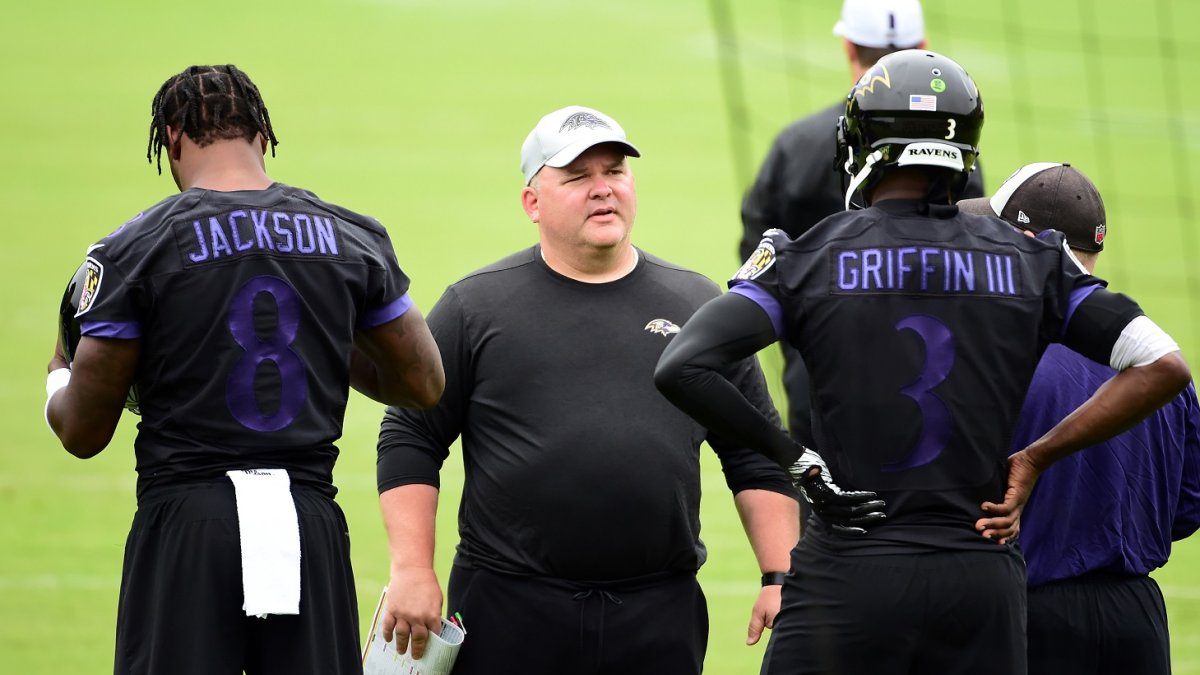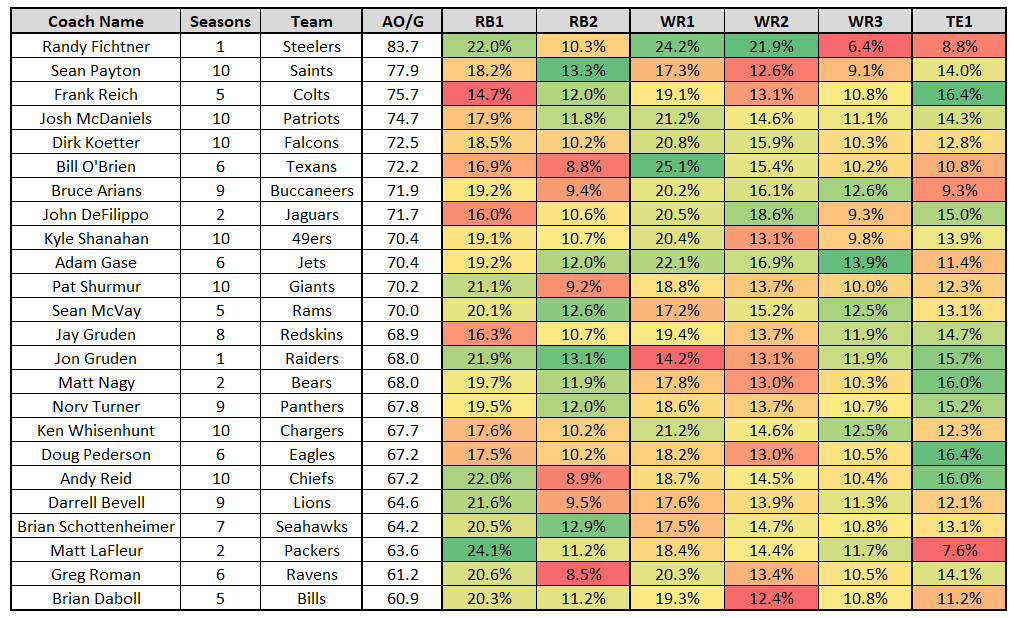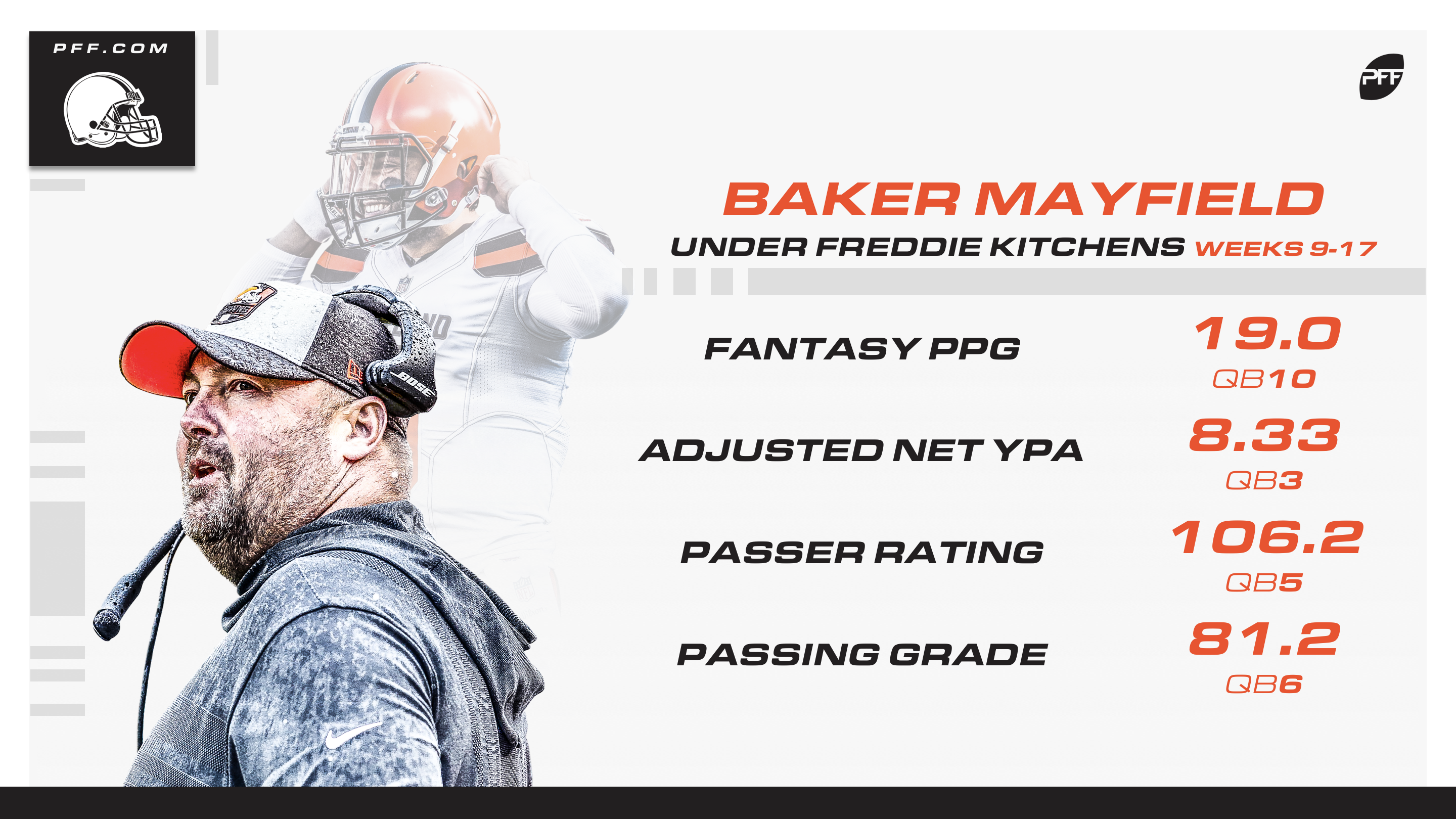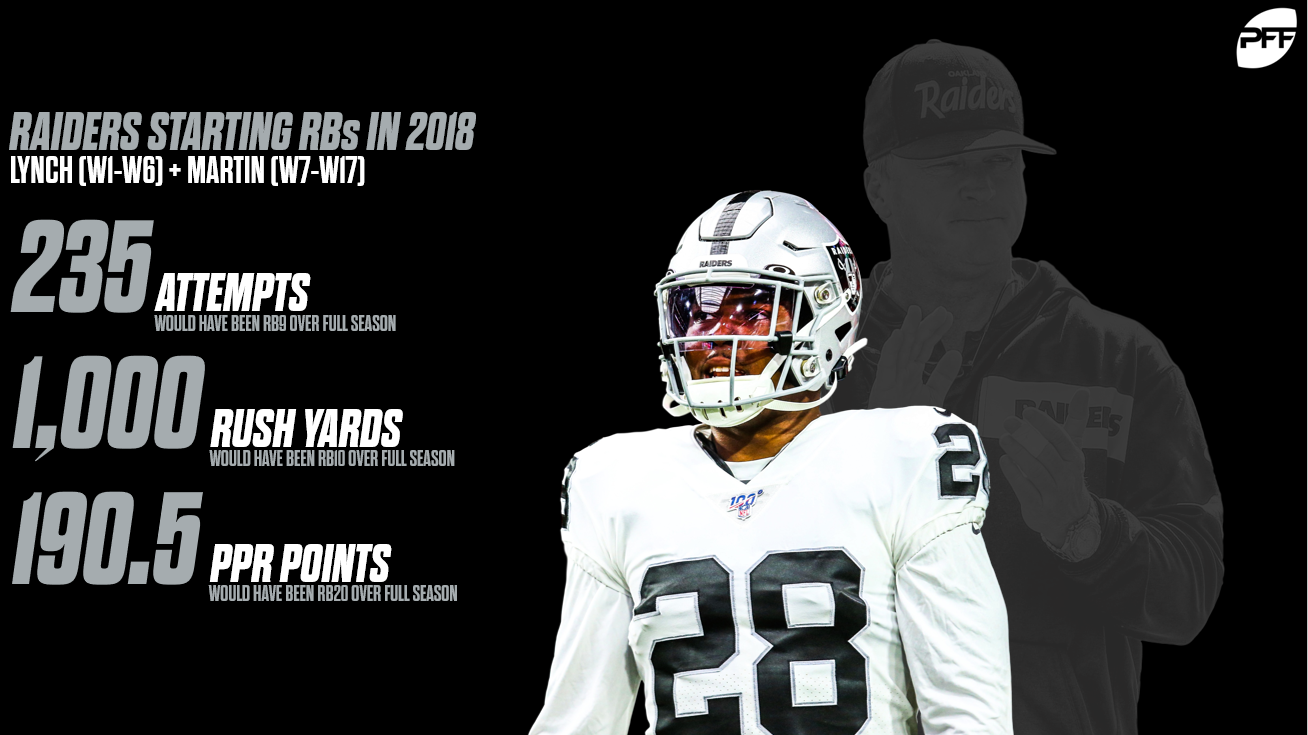Predicting fantasy football is an extremely difficult task — the number of variables one can look at is almost unlimited. Typically, when building projections, the starting place is team tendencies or, better yet, coaching tendencies. That’s what we’ll be looking at today.
Today, and in the following chart, we’re looking at every active offensive playcaller (note: a team’s offensive coordinator is not always the team’s offensive playcaller) and their historical expected fantasy production over the past decade. (Only full 16-game seasons are recognized in our data.)
Expected fantasy points measures a player’s volume in terms of fantasy points and was chosen over actual fantasy points to better help divorce a coach’s player or roster talent with positional usage. This is still a noisy and imperfect exercise, but I’ll do my best to sort through that noise in the analysis below.
The above table breaks down each active playcaller by expected fantasy point market share at each position throughout a play-caller’s historical sample. Each positional grouping (e.g. WR1 vs. WR2 vs. WR3) is split by expected fantasy point market share (in games active) over the course of a full season. In instances where a higher-ranking player (e.g. RB1) missed time with an injury, the next-closest player (e.g. RB2) would assume that designation in the interim.
For each of the 16 AFC playcallers listed below, I’ll try to highlight a few key stats from this chart (and the chart from our NFC article) and focus in on the most important fantasy-relevant takeaways:
Baltimore Ravens
Greg Roman (NFL experience as a head coach, offensive coordinator, or play-caller: 6 years)
- Among all coaches with three or more years of experience, Roman ranks fourth in RB1 expected fantasy point market share (20.6%)
Roman ranks lowly overall and last in total expected fantasy points per game. However, his arrival should be good news for Lamar Jackson. Roman coached Colin Kaepernick and Tyrod Taylor (mobile quarterbacks like Jackson) in their most productive fantasy seasons. In 2013, Kaepernick finished ninth in total fantasy points. In 2015, Taylor ranked sixth in fantasy points per game, one season before ranking seventh. As evident by the stat above, Mark Ingram may also have more bell cow potential than current ADP implies.
Buffalo Bills
Brian Daboll (6 years)
- Daboll offenses have averaged just 61.4 plays per game (second-worst)
In Daboll, we should expect Buffalo to remain a low-upside, run-heavy offense. In five seasons as an offensive coordinator, his teams have ranked top-six in rushing attempts four times and bottom-five in passing attempts six times.
Cincinnati Bengals
Zac Taylor (0 years)
Taylor called plays for the Dolphins for only five games in 2015, but otherwise has no playcalling experience at the NFL level. My one hope with Taylor was that Joe Mixon might finally be used as a bell cow running back. However, that seems unlikely. The Athletic’s Paul Dehner thinks Giovani Bernard will see 11-13 touches per game in 2019. Following Clint Boling’s retirement and injuries to Jonah Williams and Billy Price on the offensive line, this makes Mixon far too risky at ADP.
Cleveland Browns
Freddie Kitchens (0 years)
- From Week 9 (when Kitchens started calling plays for the Browns) until the end of the regular season, Baker Mayfield ranked 10th among quarterbacks in fantasy points per game (19.0), third in adjusted net yards per attempt (8.33), fifth in passer rating (106.2), and sixth in PFF pass grade (81.2).
- During Weeks 9-17 under OC Kitchens, the Browns ran 57.6 plays per game (fourth-fewest).
We don’t have much to go on with Kitchens, though our small sample size suggests efficiency should be good while volume (pace of play) is far more suspect. It’s also encouraging the team hired Todd Monken to be the team’s offensive coordinator. In his first season as a playcaller, Monken oversaw a Tampa Bay Buccaneers offense that totaled 5,125 passing yards – or the fourth-most by any team in NFL history. He’ll hopefully have a positive impact on the offense though Kitchens will remain the play-caller.
Denver Broncos
Rich Scangarello (0 years)
Scangarello has never called plays at the NFL level, but he was the 49ers’ quarterbacks coach in George Kittle’s record-breaking year last year. During Denver’s Day 1 post-draft press conference, John Elway admitted the hiring of Scangarello played a role in the team’s decision to draft Noah Fant in the first round.
Houston Texans
Bill O’Brien (6 years)
- O’Brien ranks second in plays per game (66.8)
- Among all coaches with at least three years of experience, O’Brien ranks first in WR1 expected fantasy point market share (25.1%)
- Since O'Brien took over as the head coach in 2014, Houston ranks first in rushing attempts per season (479.8).
- Among all coaches with at least three years of experience, O’Brien ranks bottom-three in RB1 (16.9%) and RB2 (8.8%) expected fantasy point market share.
- Among all coaches with at least three years of experience, O’Brien’s TE1 ranks third-worst in expected fantasy points per game (7.8)
By now, I think we know what to expect from O’Brien. His team will rank highly in rushing attempts, but his running backs won’t rank highly in fantasy points due to committee usage, a poor offensive line, and a low target market share. Deandre Hopkins should continue to see elite volume.
Indianapolis Colts
Frank Reich (5 years)
- Reich ranks tied for third in plays per game (66.7)
- Among all coaches with at least three years of experience, Reich ranks second in total expected fantasy points per game.
- Among all coaches with at least three years of experience, Reich’s RB2 ranks second in expected fantasy points per game (9.1)
- Among all coaches with at least three years of experience, Reich ranks first in TE1 expected fantasy point market share (16.4%)
Based on Reich’s history, we should expect more of the same in 2019: A committee backfield between Marlon Mack and Nyheim Hines. A lot of fantasy points to go around. And at least one tight end ranking highly in fantasy points scored. However, I’m not so sure that’s what we actually should expect.
This preseason, Indianapolis has been running 11 personnel at a significantly higher rate. Rookie Parris Campbell (the likely WR3) would be the main beneficiary of this scheme-shift, while one or both of the tight ends will be at more of a disadvantage. Last season, Eric Ebron ranked fourth in fantasy points per game, but Jack Doyle out-targeted Ebron 32 to 22 in games both were active. In Indianapolis’ last preseason game, Doyle out-snapped Ebron 13 to 9 with the first-team offense. Ebron is a fade for me, while Doyle is a fine last-round pick. Mack might also see more of a bell cow workload this season. From Weeks 1-15, last year, Hines averaged 22.5 routes run per game to Mack's 12.6. Across the team's final four games, that flipped to 22.0 to 14.0 in Mack's favor. In the team’s last preseason game, he played on 16 of 19 snaps with the first-string offense.
Jacksonville Jaguars
John DeFilippo (2 years)
- DeFilippo’s TE1 ranks fifth-best in expected fantasy points per game (10.8)
When DeFilippo was asked how much of the decision to draft a tight end (Josh Oliver) in the third round had to do with Nick Foles’ preference for targeting tight ends, DeFilippo responded, “Huge.” Since entering the league, Foles has targeted tight ends on 23% of his attempts, the fourth-highest rate of 31 qualifying tight ends. Not only does Foles love throwing to tight ends, but so, it seems, does DeFilippo. In his only full season as an offensive coordinator (2014), Gary Barnidge totaled 1,043 yards and ranked second at the position in targets (125). In all previous seasons (seven), Barnidge had never reached even 250 yards.
Kansas City Chiefs
Andy Reid (10 years)
- Among all coaches within a sample of three or more years of experience, Reid ranks first in RB1 expected fantasy point market share (24.1%) and tied for first in RB1 expected fantasy points per game (14.8).
- In 12 of the last 15 seasons, Reid’s RB1 has finished top-eight among running backs in fantasy points per game. No other head coach or offensive coordinator comes close.
- Among all coaches within a sample of three or more years of experience, Reid’s TE1 ranks fourth-best in expected fantasy points per game (10.7)
For all of the reasons I’ve outlined earlier this offseason, I still feel good about drafting Damien Williams as ADP. He’s the safe bet to be the team’s lead running back. However, if I’m drafting Williams, I don’t want to leave the draft without grabbing his handcuff in Darwin Thompson — whom I also love. Reid’s wide receiver history is underwhelming (just six top-20 finishes over his past 20 seasons), but I’m not reading too much into it – having Patrick Mahomes as your quarterback changes everything.
Los Angeles Chargers
Ken Whisenhunt (10 years)
- Whisenhunt ranks third-worst in plays per game (61.6)
- Among all coaches with at least three years of experience, Whisenhunt ranks tied for third in WR1 expected fantasy point market share (21.2%)
Whisenhunt’s offense shouldn’t look too much different than the offense we saw in 2017 and 2018. The one concern is pace of play. Philip Rivers ranked just 28th in dropbacks per game last year. Across his previous four seasons, he ranked ninth of 37 qualifying quarterbacks in dropbacks per game (39.9). That number will need to improve in order for the majority of Los Angeles’ pass-catching options to return value at ADP, though, based on Whisenhunt’s history, Keenan Allen seems safest.
Miami Dolphins
Chad O’Shea (0 years)
O’Shea has never called plays at the NFL level, but has spent 10 seasons in the Patriots organization. It’s likely Miami’s 2019 offense looks a lot like what we’ve seen from Josh McDaniels throughout his career (see below).
New England Patriots
Josh McDaniels (10 years)
- McDaniels ranks first among all coaches in plays per game (67.0)
- Among all coaches with at least three years of experience, McDaniels ranks third in WR1 expected fantasy point market share (21.2%)
- He ranks above average in RB2, WR2, WR3, and TE1 expected fantasy points per game.
Rob Gronkowski’s departure throws a wrench into things a bit, but otherwise everything should remain the same – a fast-paced offense with a lot of fantasy potential and a running back by committee approach.
New York Jets
Adam Gase (6 years)
- Among all coaches with at least three years of experience, Gase ranks second in WR1 expected fantasy point market share (22.1%), while also ranking first for WR2s (16.9%) and first for WR3s (13.9%). Impressively, his WR3 would rank about average for WR2s.
- Among all coaches within a sample of three or more years of experience, Gase ranks perfectly average in RB1 expected fantasy points market share (19.2%), his RB2 ranks fourth-best (12.0%).
- Gase’s offense has ranked 31st, 29th, 31st, and 27th in pace of play in game-neutral situations over the past four years.
- Only once in his six-year career (as an offensive coordinator or head coach) has a Gase-led team ranked top-10 in rushing attempts or rushing yards. Only once has a Gase-led team ranked top-15 in targets to running backs.
The takeaways here are pretty straightforward. There are some very real reasons to be skeptical of Le’Veon Bell’s current ADP. Gase’s slow-paced approach caps the offense as a whole. However, he’ll run 11 personnel at one of the highest rates in the league, boosting the fantasy value of the team’s tertiary wide receivers. All of Robby Anderson, Jamison Crowder, and Quincy Enunwa could prove to be fantasy-relevant this year.
Oakland Raiders
Jon Gruden (1 year)
Our data on Gruden are muddied — a one-year sample over the past decade, or an 11-year sample from over a decade ago. My biggest takeaway with Gruden is this: In April, he had this to say of Josh Jacobs — “My expectation for him — if you’re listening, Josh — I encourage you to get some rest because we’re going to run you a lot. We’re going to give you a great opportunity.” This came immediately after GM Mike Mayock referred to him as a “three-down running back.”
Gruden didn’t use a bell cow last season, but if we treated Marshawn Lynch and Doug Martin as one player (based on games started), they would have combined to rank ninth in carries and 20th in fantasy points. Of Gruden’s former running backs, Michael Pittman is probably the best example of a workload to except from Jacobs. In 2002-2004, Pittman averaged 203 carries and 91 targets per season. By weighted opportunity, that’s mid-range RB1 volume.
Pittsburgh Steelers
Randy Fichtner (1 year)
- Fichtner leads all play-callers in RB1, WR1, WR2, and total expected fantasy points per game. However, with just one year of experience, it’s hard to find too many real takeaways.
Who receives the bulk of Antonio Brown’s vacated 168 targets? Could JuJu Smith-Schuster lead all wide receivers in fantasy points this year? Who are the team’s WR2 and WR3? Where does Vance McDonald rank on the target pecking order? These are tough questions to answer, but the thing I’m most confident in is that James Conner is still the team’s bell cow running back and should be a first-round pick.
Tennessee Titans
Arthur Smith (0 years)
Smith has never called plays at the NFL level, so it’s hard to come up with a meaningful takeaway other than that we should probably expect a healthy Delanie Walker to remain heavily involved in the team’s passing game. Smith was Walker’s tight ends coach from 2014 to 2018. Prior to last season, Walker had finished sixth, sixth, third, and seventh among tight ends in fantasy points per game.






 © 2025 PFF - all rights reserved.
© 2025 PFF - all rights reserved.